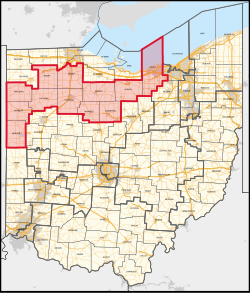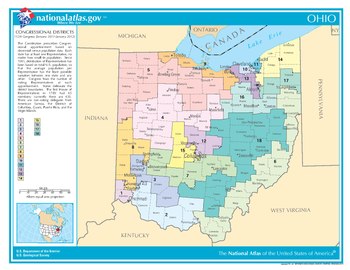2022 redistricting
On November 17, 2021, after lengthy discussions, a new map was passed by the Ohio House of Representatives 55-36, along party lines, with no Democrat voting in favor of the map. [8] The map was sent to Governor of Ohio, Mike DeWine, where he accepted it 3 days later on November 20. [9]
The map was controversial, with Democrats accusing the map of being purposefully designed to benefit Republicans. [8] [9] By December 7, 2021, six lawsuits had been filed against the new 15-seat congressional map, citing it as "racially discriminatory" and a partisan gerrymander. The proposed map favored Republican to Democratic districts by a 12-3 margin. [10]
On January 14, 2022, the Ohio Supreme Court declared the map a partisan gerrymander, violating Article XIX of the Constitution of Ohio, in a 4-3 decision. The Ohio General Assembly had 30 days to draw a new map, but declined to do so, passing the buck to the same 7-member political Ohio Redistricting Commission in charge of Ohio's contentious legislative redistricting. [11]
On March 2, 2022, the Ohio Redistricting Commission adopted a second Congressional map along party lines. [12] In the midst of ensuing legal maneuvers over this map, Ohio's 2022 primary for Congressional seats was held as scheduled on May 3, 2022, though this election did not include state legislative races, as a third set of statehouse map had been rejected on March 16, 2022 by the Ohio Supreme Court. [13] On July 19, 2022, the Ohio Supreme Court, again on a bitterly divided 4-3 vote, ruled that the second Congressional map was also a partisan gerrymander and ordered a redraw within 30 days, but the 2022 general election was allowed to proceed on this invalidated map. [14] Neither the state legislature nor the Ohio Redistricting Commission responded to the court's order to redraw the map.
In the 2022 general election, Republicans won the seat occupied by the retiring Chief Justice Maureen O'Connor, swinging the court toward the faction that had dissented from the earlier opinions. [15] In response, the lawsuits over the second Congressional map were dropped, as the litigants feared the new court would permit an even greater gerrymander than the map enacted on March 2, 2022. [16] As that map did not have bipartisan support, per Ohio Constitution Article XIX it is a four-year map that must be redrawn prior to the 2026 elections. [17] A 2024 citizen ballot initiative spearheaded by O'Connor, proposing to wrest legislative and Congressional redistricting power away from Ohio politicians into a citizen redistricting commission and enforce strict proportionality failed essentially along party lines, based on analysis of county- and precinct-level voting results on the issue relative to U.S. Presidential voting. [18] [19]

































